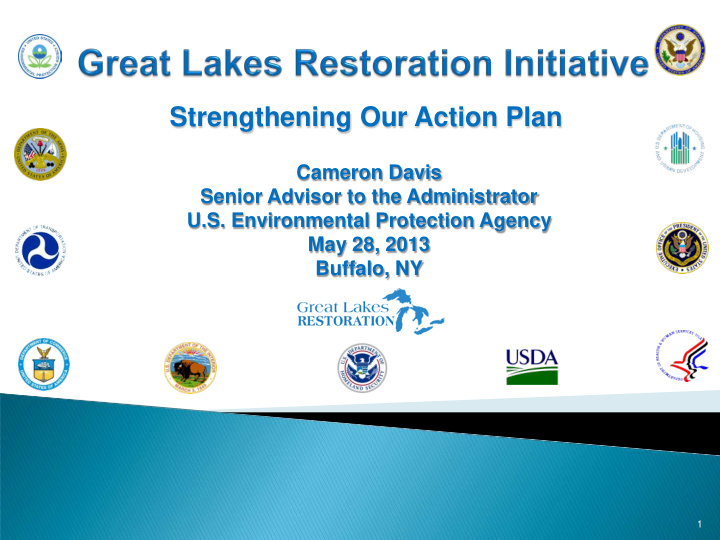



Strengthening Our Action Plan Cameron Davis Senior Advisor to the Administrator U.S. Environmental Protection Agency May 28, 2013 Buffalo, NY 1
Welcome – This is YOUR Plan GLRI FY10-14 – Background ◦ Action Plan ◦ Results GLRI FY 15-19 – Assumptions ◦ Short, effective planning process ◦ Adaptive Science Comments, Questions, Discussion 2
“ The Great Lakes Restoration Initiative, as it is called, is a truly bipartisan and binational enterprise, involving leaders and groups from eight states, innumerable communities, the two major U.S. political parties…The 30 million people who live in this region make it a major political battleground. In an age of rampant distrust, I can't think of a better way to show that government can work. “ David Broder, Washington Post February 25, 2010 3
The agencies have removed 24 Beneficial Use Impairments at 11 Areas of Concern since 2009. Led by White House Council on Environmental Quality, federal, state, provincial and municipal partners have helped keep Asian carp from becoming established in the Great Lakes. Swimming bans and advisories have been at a five-year low at Chicago’s beaches due in part to clean beach practices supported in part by GLRI. 4
5
6
• This is YOUR plan. • “Short and sweet” planning process. • The GLRI is an “accelerator,” not a stand-alone program. • The Federal agencies are considering changes they think are warranted: • Fulfillment of GLWQA • Adjustments to MOPs • Consider indicators • Adaptive Science-Based Framework 7
Currently climate change impacts and adaptation are not explicitly included in the Action Plan. Should the connection between the Action Plan focus areas and the protection of the Great Lakes from the impacts of climate change be expressed more clearly in the next Action Plan? If so, how? In FY13, the federal agencies emphasized investments on three “priority” subjects: (1) expediting AOC cleanups, (2) reducing nutrients in priority watersheds, and (3) preventing the establishment of invasive species, particularly Asian carp. Should we keep or modify these three priorities? ◦ If we keep the current priority to expedite AOC cleanups, should we continue to balance our investments in efforts to so that we are completing all management actions to take some AOCs off the cleanup list soon while continuing to invest in AOCs that may not be taken off the cleanup list for several years? 8
In FY13, the federal agencies emphasized investments on three “priority” subjects: (1) expediting AOC cleanups, (2) reducing nutrients in priority watersheds, and (3) preventing the establishment of invasive species, particularly Asian carp. Should we keep or modify these three priorities? The federal agencies have targeted three priority watersheds for accelerated ◦ nutrient reduction work: (1) Maumee River/Western Lake Erie, (2) Lower Fox River/Green Bay, (3) Saginaw River/Bay watersheds. If we keep the current priority to reduce nutrients in priority, should we also continue to focus conservation activities to have a stronger impact in some sub-watersheds of these three priority watersheds? Or should we disperse our conservation activities so they may have a wider geographical impact throughout the three priority watersheds (but potentially weaker impact across sub-watersheds)? How can we improve participation of key landowners in conservation programs in these watersheds? If we keep the current priority to prevent invasive species from becoming ◦ established, should we target our GLRI investments at a few specific species? Or should we address other invasive species, too, and if so, which ones? How do we strike the right balance between investing in the control of invasive species already in the Great Lakes and preventing new invasive species from entering them? 9
How should the next Action Plan provide better guidance on the selection and prioritization process for restoration projects outside of AOCs? Should the next Action Plan give priority to activities that leverage non-GLRI funding, where applicable, thereby enabling the GLRI funding to do more? Should it give greater priority to large-scale restoration projects ($3-10M) that are less likely to ever be realized without GLRI resources? 10
Should the GLRI track jobs created or sustained through GLRI projects? Should the GLRI help promote environmental justice and support disadvantaged communities? Should scientific indicators developed by the International Joint Commission or other official processes be considered for use refining Measures of Progress or other aspects of the GLRI Action Plan? If so, how should indicators be taken into account in the next GLRI Action Plan? 11
Helps refine investment decisions based on best available science Brief History ◦ Appropriations Requirement ◦ SAB Two Major Recommendations ◦ Adaptive decision-making process ◦ Information System 12
GLAB: June 12 Public Meetings ◦ May 28 – Buffalo ◦ May 30 – Milwaukee ◦ June 5 - Cleveland Webinar: ◦ Monday, June3, 2013 5:00 PM - 7:00 PM CDT ◦ Registration Web Link: https://www1.gotomeeting.com/register/911554472 Email for Comments ◦ Action plan: actionplan@glnpo.net ◦ Science framework: science@glnpo.net Public Comment Period Deadline July 12 For more info: http:/glri.us 13
Recommend
More recommend